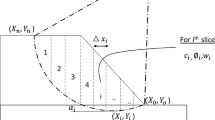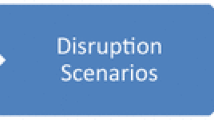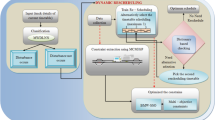Abstract
Numerous disruptive incidents including technical issues as well as natural disasters have affected Railway Networks (RN) in the past few decades. For optimizing the RN, the work created a novel RN architecture with four separate modules. The infrastructure module allots disruption to the RN. The control system module defines whether the RN is disrupted or not utilizing the Gaussian Membership Function-based Fuzzy Decision Making (GMF-FDM) process. If it is interrupted, it is evaluated at the train service together with the passenger network, and the operational module is triggered. Two main operations are being executed by the operational module: (i) Improved Cockroach Swarm Optimization (ICSO) reroute the trains by means of ascertaining the shortest route, as well as (ii) Mixed Integer Linear Programming (MILP) reschedule the train's timings in relation to the passenger. Based on train, passenger, along with station data, significant constraints were extracted, which were inputted to the Vulnerability Assessment (VA) module. In which, the chosen paths vulnerability is assessed by the proposed Enhanced Elman Deep Learning Neural Network (EEDLNN). An accuracy of 96.61% is obtained by the experimental outcome, which is better when weighed against the conventional methods.








Similar content being viewed by others
References
Ouyang, M., Liu, C., & Wu, S. (2020). Worst-case vulnerability assessment and mitigation model of urban utility tunnels. Reliability of Engineering System Safety, 197, 106856. https://doi.org/10.1016/j.ress.2020.106856
Savsar, M. (2013). Modeling and simulation of maintenance operations at Kuwait public transport company. Kuwait Journal of Science, 40, 115–129.
Bešinović, N. (2020). Resilience in railway transport systems: A literature review and research agenda. Transportation Review, 40, 457–478. https://doi.org/10.1080/01441647.2020.1728419
Hong, L., Ye, B., Yan, H., Zhang, H., Ouyang, M., & Sean He, X. (2019). Spatiotemporal vulnerability analysis of railway systems with heterogeneous train flows. Transportation Research Part A Policy Practicle, 130, 725–744. https://doi.org/10.1016/j.tra.2019.09.055
Li, T., Rong, L., & Yan, K. (2019). Vulnerability analysis and critical area identification of public transport system: A case of high-speed rail and air transport coupling system in China. Transportation of Research Part A Policy Practicle, 127, 55–70. https://doi.org/10.1016/j.tra.2019.07.008
Bababeik, M., Khademi, N., Chen, A., & Nasiri, M. M. (2017). Vulnerability analysis of railway networks in case of multi-link blockage. Transportation of Research Procedia., 22, 275–284. https://doi.org/10.1016/j.trpro.2017.03.034
Xing, Y., Lu, J., Chen, S., & Dissanayake, S. (2017). Vulnerability analysis of urban rail transit based on complex network theory: A case study of Shanghai Metro. Public Transportation, 9, 501–525. https://doi.org/10.1007/s12469-017-0170-2
Liu, J., Lu, H., Ma, H., & Liu, W. (2017). Network vulnerability analysis of rail transit planin Beijng-Tianjin-Hebei region considering connectivity reliability. Sustain. https://doi.org/10.3390/su9081479
Jiang, R., Lu, Q. C., & Peng, Z. R. (2018). A station-based rail transit network vulnerability measure considering land use dependency. Journal of Transportaion of Geography, 66, 10–18. https://doi.org/10.1016/j.jtrangeo.2017.09.009
Song, L., Li, Q., List, G. F., Deng, Y., & Lu, P. (2017). Using an AHP-ISM based method to study the vulnerability factors of urban rail transit system. Sustain, 9, 1–16. https://doi.org/10.3390/su9061065
Lu, Q. C. (2018). Modeling network resilience of rail transit under operational incidents. Transportation of Research Part A Policy Practice, 117, 227–237. https://doi.org/10.1016/j.tra.2018.08.015
Fang, C., Dong, P., Fang, Y. P., & Zio, E. (2020). Vulnerability analysis of critical infrastructure under disruptions: An application to China Railway High-speed. Proceedings of the Institutional Mechanical Engineering Part O Journal of Risk Reliability, 234, 235–245. https://doi.org/10.1177/1748006X19889149
Lu, Q. C., & Lin, S. (2019). Vulnerability analysis of urban rail transit network within multi-modal public transport networks. Sustain., 11, 10–13. https://doi.org/10.3390/SU11072109
Ouyang, M., Tian, H., Wang, Z., Hong, L., & Mao, Z. (2019). Critical infrastructure vulnerability to spatially localized failures with applications to Chinese railway system. Risk Analysis, 39, 180–194. https://doi.org/10.1111/risa.12708
Sun, D. J., & Guan, S. (2016). Measuring vulnerability of urban metro network from line operation perspective. Transportation of Research Part A Policy Practice, 94, 348–359. https://doi.org/10.1016/j.tra.2016.09.024
Hong, L., Ouyang, M., Xu, M., & Hu, P. (2020). Time-varied accessibility and vulnerability analysis of integrated metro and high-speed rail systems. Reliability of Engineering System Safety, 193, 1–10. https://doi.org/10.1016/j.ress.2019.106622
Feng, C., Zhu, Q., Yu, B., & Zhang, Y. (2017). Complexity and vulnerability of high-speed rail network in China. Chinese Control Conference CCC. https://doi.org/10.23919/ChiCC.2017.8028958
Bababeik, M., Khademi, N., & Chen, A. (2018). Increasing the resilience level of a vulnerable rail network: The strategy of location and allocation of emergency relief trains. Transportation of Research Part E Logistic Transportation Review, 119, 110–128. https://doi.org/10.1016/j.tre.2018.09.009
Xiao, H., Huang, S., Hang, B., & Wang, X. (2020). Optimization of operation scheme for express freight railway. Kuwait Journal of Science, 48, 94–103. https://doi.org/10.48129/kjs.v48i1.7800
Arsuaga, I., Toledo, N., Lopez, I., & Aguado, M. (2018). A framework for vulnerability detection in European train control railway communications. Security Communication of Networks. https://doi.org/10.1155/2018/5634181
Zhu, Y., & Goverde, R.M.P. (2017). System-based vulnerability measures for railway systems. In: Proceedings of the 7th international conference on railway operative modelling analaysis RailLille2017 Lile.
Szymula, C., & Bešinović, N. (2020). Passenger-centered vulnerability assessment of railway networks. Transportation of Research Part B Methodology, 136, 30–61. https://doi.org/10.1016/j.trb.2020.03.008
Ma, F., Liang, Y., Yuen, K. F., Sun, Q., Zhu, Y., Wang, Y., & Shi, W. (2020). Assessing the vulnerability of urban rail transit network under heavy air pollution: A dynamic vehicle restriction perspective. Sustainable Cities Society, 52, 101851. https://doi.org/10.1016/j.scs.2019.101851
Hong, L., Ouyang, M., Peeta, S., He, X., & Yan, Y. (2015). Vulnerability assessment and mitigation for the Chinese railway system under floods. Reliability of Engineering System and Safety, 137, 58–68. https://doi.org/10.1016/j.ress.2014.12.013
Sun, L., Huang, Y., Chen, Y., & Yao, L. (2018). Vulnerability assessment of urban rail transit based on multi-static weighted method in Beijing, China. Transportation of Research Part A Policy Practice, 108, 12–24. https://doi.org/10.1016/j.tra.2017.12.008
Almulla, M., Almatori, K., & Yahyaoui, H. (2011). A QoS-based fuzzy model for ranking real world Web services. In: Proceedings of the 2011 IEEE 9th International Conference on Web Services ICWS 2011. Pp. 203–210. doi:https://doi.org/10.1109/ICWS.2011.43.
Almulla, M., Yahyaoui, H., & Al-Matori, K. (2015). A new fuzzy hybrid technique for ranking real world Web services. Knowledge-Based System, 77, 1–15. https://doi.org/10.1016/j.knosys.2014.12.021
Allahverdi, A. (2006). Two-machine flowshop scheduling problem to minimize maximum lateness with bounded setup and processing times. Kuwait Journal of Science and Engineering, 33, 233–252.
Ilyin, I. Y., Pushkarevsky, N. A., Kuratieva, N. V., Naumov, D. Y., & Konchenko, S. N. (2012). = 3 and 4), Acta Crystallography Section C Crystline Structure. Communication, 68, m323–m325.
I.R. [WWW D.U. http://enquiry. indianrail. gov. in/ntes/Trains. National Train Enquiry System -, I. NTDPC. India transport Report: Moving India to 2032. (Delhi, No Title, (n.d.).
Author information
Authors and Affiliations
Corresponding author
Additional information
Publisher's Note
Springer Nature remains neutral with regard to jurisdictional claims in published maps and institutional affiliations.
Rights and permissions
About this article
Cite this article
Kumar, N., Mishra, A. EEDLNN Algorithm for Assessing the Vulnerability in Railway Network with Respect to Passengers and Trains. Wireless Pers Commun 127, 2535–2552 (2022). https://doi.org/10.1007/s11277-021-09080-0
Accepted:
Published:
Issue Date:
DOI: https://doi.org/10.1007/s11277-021-09080-0




